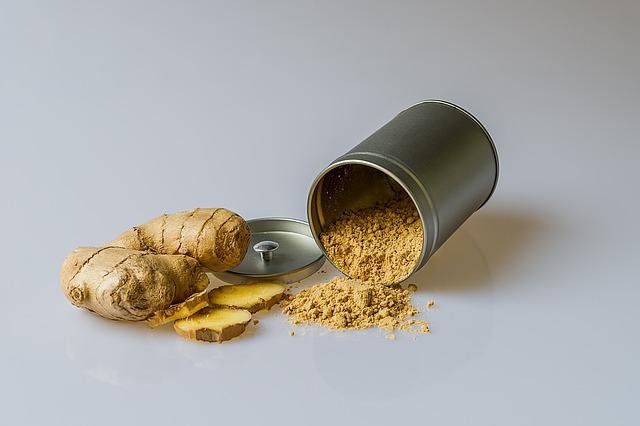
Tonic, stimulant, digestive, anti-inflammatory and much more.. this is ginger. A spice with great healing properties! Find out what it is for, its properties and possible contraindications.
Rich in properties, Ginger (Zingiber officinale Roscoe), also known by the English name Ginger, is a perennial herbaceous plant, about 90cm tall and belonging to the Zingiberacee family.
The Ginger plant has an underground stem, formed by a branched rhizome from which the vegetative stems are born. The medicinal part of ginger is precisely the rhizome (which most people mistakenly call it root), rich in essential oil, gingerin, zingerone, resins and mucilage.
The Ginger plant has an underground stem, formed by a branched rhizome from which the vegetative stems are born. The medicinal part of ginger is precisely the rhizome (which most people mistakenly call it root), rich in essential oil, gingerin, zingerone, resins and mucilage.
Native to India and Malaysia, ginger develops best in tropical places (with high temperatures and high humidity) but growing ginger is not that difficult for us too, both in full ground and in pots (but it has to be large because the plant develops in width). To grow ginger at home, you can take the rhizome and plant it under the ground a few centimeters. Water often but with little water (it is also good to spray it with water to recreate the humidity typical of countries of origin). In winter you have to be careful of low temperatures that can damage the plant.
The ginger rhizome is rich in essential oils and gingerol, shogaol and paradol, and for its beneficial properties it has been used for many years in oriental medicine. European medicine has also always recognized its healing properties of this plant, which is listed among those used and studied by Galen and later also by the Romans, as evidenced by the writings of Pliny the Elder.
Subsequently, the benefits brought by the consumption of ginger have continued to fascinate and in recent years there have been numerous studies conducted to highlight all its capabilities in a more specific way.
Ginger is increasingly consumed also in Western kitchens and we find it easily in all our supermarkets. It can be purchased fresh or grated and dried, in the form of powder. In the first case, the beneficial properties of the plant are better maintained; in the second case there is the advantage of being able to keep the product for a longer time.
The properties of Ginger
Ginger is rich in various beneficial minerals such as magnesium, iron, zinc and some B vitamins and vitamin E. In addition to these fundamental nutrients, it is rich in some essential polyphenols, which guarantee the spice the many healing properties it enjoys. Let’s now see in detail its nutritional characteristics and then understand in detail what ginger is used for.
Nutritional values per 100g of fresh ginger:
- Waterfall: 78.89 g
- kcal: 80
- Proteins: 1.82 g
- Carbohydrates: 17.77 g
- Fibers: 2.0 g
- Fat: 0.75 g
- Sodium: 13 mg
- Potassium: 415 mg
- Phosphorus: 34 mg
- Soccer: 16 mg
- Magnesium: 43 mg
- Iron: 0.6 mg
- Zinc: 0.34 mg
- C vitamin: 5 mg
- Vitamin B2: 0.034 mg
- Vitamin B3: 0.75 mg
- Vitamin B6: 0.16 mg
- Folate: 11 µg
- Vitamin E: 0.26 mg
- Glycemic index: 15
- Cholesterol: 0 g
✓ Ginger against nausea
Among the many virtues, ginger is used to reduce nausea. Thanks to its properties, it is traditionally used as a digestive and bitter-tonic. There are several studies that have shown a real efficacy of ginger against nausea, in particular it is highly appreciated in case of pregnancy nausea (where the consumption of ginger has statistically decreased the feeling of vomiting), motion sickness and seasickness. For this purpose, an infusion prepared with 5 grams of ginger root in 1/2 liter of water or the chewing root is very effective against nausea.
✓ A valid help against ulcer and gastritis
Ginger is good for the whole digestive system thanks to its gastroprotective properties and is very useful (if used in low doses) even against gastritis and intestinal ulcers. The active ingredients of ginger are in fact very effective against Helicobacter pylori, the bacterium responsible for stomach ulcers.
✓ Digestive ginger and useful to deflate the belly
Ginger stimulates digestion, fights diarrhea and helps eliminate intestinal gas, making it a useful remedy for a swollen belly.
✓ In case of flu states
Stimulating the immune system, ginger has been used by Asian populations for thousands of years to fight colds and fever. It is also a great help against cough and phlegm. Thanks to its antiseptic and anti-inflammatory properties, ginger is also of great help in case of throat inflammation (pharyngitis, laryngitis, etc.).
✓ Antiviral and antimicrobial properties of ginger
Ginger also possesses a well-documented antiviral and antimicrobial effect. Its consumption can therefore help in case of infections of various kinds. For example, the effect of ginger in cases of human respiratory syncytial virus infection was demonstrated in 2013 : fresh (and not dehydrated) ginger is able to inhibit the adhesion of the virus to human cells.
✓ Anti-inflammatory and analgesic
Recent studies have shown that ginger, thanks to its strong anti-inflammatory properties, relieves headaches, effectively reduces joint and muscle pain and relieves inflammation of the stomach and esophagus.
✓ Ginger: ally of the heart
The ginger rhizome is a good anticoagulant and as such helps to thin the blood and reduce the risk of clot formation. In addition, ginger is an ally of the heart as it lowers cholesterol levels. In particular, the consumption of ginger showed an improvement in blood levels of total cholesterol and LDL-cholesterol. Consequently, thanks also to the anti-inflammatory effect, the consumption of ginger is able to prevent the formation of atherosclerotic plaques and subsequent cardiovascular diseases.
Finally, according to some scientific studies, ginger decreases blood pressure as it acts as a vasodilator and, as we have just seen, reduces blood clotting.
✓ Ginger and type 2 diabetes
Several evidences underline the effect of ginger consumption on blood sugar and insulin resistance. In particular, in a study conducted on 88 participants, the consumption of 3 grams of ginger per day for 8 weeks resulted in a 10% reduction in blood sugar.
✓ Useful against menstrual pain
Using ginger during the first days of the menstrual cycle can help relieve the pain associated with the menstrual cycle. Also in this case, ginger has an anti-inflammatory effect and according to studies the benefits brought by this plant are comparable to those brought by the common drugs in use, which however have greater side effects.
✓ Stimulates the metabolism
Ginger, like other spices, has thermogenic properties, which means that it can stimulate the metabolism, thus helping to burn more calories. It is mainly for this reason that ginger is recommended as an extra aid in weight loss diets.
✓ Cancer prevention
Ginger, and in particular the gingerols and shogaols contained in it, seem to demonstrate an anti-proliferative effect on various tumor lines. The action was particularly seen in prostate, gastrointestinal, pancreatic and hepatic cancers. Research has also shown how shogaoli would be able to inhibit cell growth and at the same time simulate apoptosis, or programmed cell death. It would also seem that the toxic effect is not exerted on healthy cells.
Furthermore, recently a group of researchers would have highlighted the anticancer properties of this spice in cases of colorectal carcinomas: taking ginger every day in fact, would have a protective function against colorectal cancers. The lead researcher of the study, said: ” Plants of the ginger family are attributed with preventive and therapeutic powers, as well as an anti-cancer activity .”
A few tips on how to use ginger
✓ Use Ginger in the kitchen
The rhizome (also called root) of this plant is used in cooking, often grated or ground into powder.
This spice with a delicious and slightly spicy flavor is used in dishes based on meat, fish and vegetables. It is also widely used to prepare cakes and biscuits (especially Christmas ones). With ginger (fresh or dry) you can prepare an excellent decoction with digestive properties. Sometimes the shoots, leaves and inflorescences are also used and can be eaten raw or cooked. Ginger is used fresh or dried, both in pieces and in powder for use on numerous culinary preparations. To cut fresh gingerjust take a knife, cut the desired part and peel it, being careful not to cut yourself. Later, if necessary, it can be cut into smaller pieces.
✓ Use ginger for therapeutic purposes: how much to use?
Ginger can be used externally or internally. In the first case, it is possible to resort to ginger packs to be applied locally to counteract arthritis and muscle pain .
Internally, however, it can be used in different forms. In general, to benefit from the properties of ginger, you can use an herbal tea, or it can be used in the form of a powder (about 1 g) to be mixed with a glass of hot water.
To make the ginger herbal tea, proceed as follows: cut into thin slices (or small cubes) about 10 grams of fresh root deprived of the outer skin, let it boil in water for 7/8 minutes, turn off the heat and filter. Alternatively you can prepare an herbal tea with dry ginger, the procedure is the same but use about 1 gram. Once you have prepared your ginger tea you can enjoy it as it is or add honey and / or lemon juice to taste.
In addition, ginger can be taken in the form of capsules, liquid or dry extract to be used according to the instructions on the package. A good ginger supplement should have a titration of at least 4% gingerols.
Finally, on the market there is also the essential oil of ginger, to be diffused in the air or to be used through the skin.
How much ginger to eat per day
A piece of fresh or dried root can be chewed if necessary in case of intestinal pain, nausea or stomach cramps. Generally it is recommended not to take more than 15/20 grams of fresh rhizome or 3/4 grams of dry root or powder per day, to avoid the onset of annoying intestinal disorders.
As for the extracts, however, according to commission E, the doses to obtain benefits with ginger extracts are: Fluid extract 1: 1 (g / ml): 0.25-1 ml, three times a day; Mother tincture 1: 5 (g / ml): 1.25-5 ml, three times a day. In any case it is always good to follow the manufacturer’s instructions.
Ginger: contraindications, side effects and interactions
Let’s now see the contraindications of ginger and when it is better not to take it. Although it is useful in case of nausea, consult your doctor before using ginger in pregnancy. Avoid taking in case of allergy to one or more components present. Ginger allergy is noted with the appearance of redness on the skin and rashes.
It is also good not to abuse ginger: the massive use of ginger can in fact cause gastritis, ulcers and intestinal swelling instead of treating them. If you suffer from these gastrointestinal disorders it is good to consult your doctor before taking this spice, who will evaluate the possibility of taking it or not (starting in any case with small doses).
Even those who take anti-inflammatory and hypotensive drugs should avoid the use of ginger. Given its blood thinning effect, it is always advisable to consult your doctor before using ginger in case you are taking antiplatelet and anticoagulant drugs (Coumadin, Cardioaspirin, etc…).
Curiosity
In ancient times the Indians used to chew ginger as a purifier of the breath before religious ceremonies: with their mouth purified they could sing and speak to the gods.






